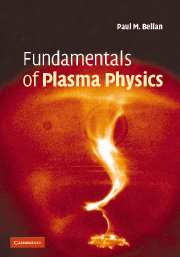Book contents
- Frontmatter
- Contents
- Preface
- 1 Basic concepts
- 2 The Vlasov, two-fluid, and MHD models of plasma dynamics
- 3 Motion of a single plasma particle
- 4 Elementary plasma waves
- 5 Streaming instabilities and the Landau problem
- 6 Cold plasma waves in a magnetized plasma
- 7 Waves in inhomogeneous plasmas and wave-energy relations
- 8 Vlasov theory of warm electrostatic waves in a magnetized plasma
- 9 MHD equilibria
- 10 Stability of static MHD equilibria
- 11 Magnetic helicity interpreted and Woltjer–Taylor relaxation
- 12 Magnetic reconnection
- 13 Fokker–Planck theory of collisions
- 14 Wave–particle nonlinearities
- 15 Wave–wave nonlinearities
- 16 Non-neutral plasmas
- 17 Dusty plasmas
- Appendices
- Bibliography and suggested reading
- References
- Index
13 - Fokker–Planck theory of collisions
Published online by Cambridge University Press: 05 June 2012
- Frontmatter
- Contents
- Preface
- 1 Basic concepts
- 2 The Vlasov, two-fluid, and MHD models of plasma dynamics
- 3 Motion of a single plasma particle
- 4 Elementary plasma waves
- 5 Streaming instabilities and the Landau problem
- 6 Cold plasma waves in a magnetized plasma
- 7 Waves in inhomogeneous plasmas and wave-energy relations
- 8 Vlasov theory of warm electrostatic waves in a magnetized plasma
- 9 MHD equilibria
- 10 Stability of static MHD equilibria
- 11 Magnetic helicity interpreted and Woltjer–Taylor relaxation
- 12 Magnetic reconnection
- 13 Fokker–Planck theory of collisions
- 14 Wave–particle nonlinearities
- 15 Wave–wave nonlinearities
- 16 Non-neutral plasmas
- 17 Dusty plasmas
- Appendices
- Bibliography and suggested reading
- References
- Index
Summary
Introduction
Logically, this chapter ought to be located at the beginning of Chapter 2, just after the discussion of phase-space concepts. This chapter is not located there because the theory in this chapter is too advanced to be so close to the beginning of the book and its location near the beginning would have delayed the introduction of other important topics that do not need the detail of this chapter.
The discussion of collisions in Chapter 1 was very approximate. Collisions were shown to scale as an inverse power of temperature, but this was based on a “one size fits all” analysis since it was assumed that collision frequencies of slow and fast particles were nominally the same as that of a particle moving at the thermal velocity. Because the collision frequency scales as v−3, it is quite dubious to assume that the collision rates of both super-thermal and sub-thermal particles can be well represented by a single collision frequency and a more careful averaging over velocities is clearly warranted. This careful averaging is provided by a Fokker–Planck analysis due to Rosenbluth, Macdonald, and Judd (1957). If this much more detailed analysis simply provided more accuracy, it would not be worth the considerable effort it requires except for occasional situations where high accuracy is important. However, the Fokker–Planck theory not only provides more accuracy, but also reveals new and important phenomena and, in particular, indicates when resistive MHD fails.
- Type
- Chapter
- Information
- Fundamentals of Plasma Physics , pp. 436 - 455Publisher: Cambridge University PressPrint publication year: 2006



